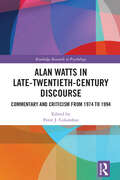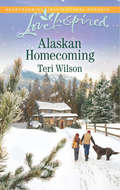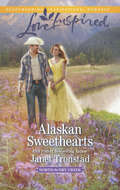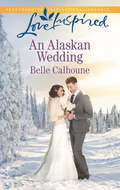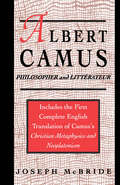- Table View
- List View
Alan Watts in Late-Twentieth-Century Discourse: Commentary and Criticism from 1974-1994 (Routledge Research in Psychology)
by Peter J. ColumbusThis book is an anthology of commentary and criticism written within the transitional period between Alan Watts’ 1973 death and the twenty-first century intellectual horizon. Comprised of 16 chapters written and published between 1974 and 1994, with up-to-date introductions from the essayists and other contemporary thinkers, this volume opens a window onto unexplored grounds of Alan Watts’ impact within late-twentieth-century discourse – an intermediate space where scholars reoriented their bearings through changing times and emerging academic trends. Offering varied explanations and assessments of Alan Watts, including his influence on the Beat and Hippie generations, and his popularization of Zen Buddhism in America, it tackles unaddressed questions within the milieu of late-twentieth-century America from the Reagan Revolution and religious conservatism, to paradigm shifts in Buddhist studies and the rise of post-colonial theory. Contributors’ post-mortem analyses and critiques of Watts allow for a thematic rendering of their consonance or dissonance with noted Beat, Hippie, and Zen Buddhism themes of his lifetime. This volume will appeal to scholars and students of humanistic psychology, transpersonal psychology, the psychology of religion, comparative religion, and American studies.
Alan Watts in Late-Twentieth-Century Discourse: Commentary and Criticism from 1974-1994 (Routledge Research in Psychology)
This book is an anthology of commentary and criticism written within the transitional period between Alan Watts’ 1973 death and the twenty-first century intellectual horizon. Comprised of 16 chapters written and published between 1974 and 1994, with up-to-date introductions from the essayists and other contemporary thinkers, this volume opens a window onto unexplored grounds of Alan Watts’ impact within late-twentieth-century discourse – an intermediate space where scholars reoriented their bearings through changing times and emerging academic trends. Offering varied explanations and assessments of Alan Watts, including his influence on the Beat and Hippie generations, and his popularization of Zen Buddhism in America, it tackles unaddressed questions within the milieu of late-twentieth-century America from the Reagan Revolution and religious conservatism, to paradigm shifts in Buddhist studies and the rise of post-colonial theory. Contributors’ post-mortem analyses and critiques of Watts allow for a thematic rendering of their consonance or dissonance with noted Beat, Hippie, and Zen Buddhism themes of his lifetime. This volume will appeal to scholars and students of humanistic psychology, transpersonal psychology, the psychology of religion, comparative religion, and American studies.
Alaskan Ambush: Lone Star Standoff Sheltered By The Soldier Alaskan Ambush (Mills And Boon Love Inspired Suspense Ser.)
by Sarah VarlandHe'll take down their pursuers…If she gets them out of the wilderness alive.
An Alaskan Christmas: Amish Christmas Twins An Alaskan Christmas Mending The Widow's Heart (Alaskan Grooms #6)
by Belle CalhouneHer Christmas Match
Alaskan Christmas Cold Case (Mills And Boon Love Inspired Suspense Ser.)
by Sarah VarlandChristmas Under Fire…The Ice Maiden Killer is back.
Alaskan Hearts (Mills And Boon Love Inspired Ser.)
by Teri WilsonInspiring and enriching romances about faith, hope and the healing power of love. WARMING HIS HEART
Alaskan Hideaway: Alaskan Hideaway In Love With The Firefighter Finding Her Family A Home For Her Baby (A Northern Lights Novel #3)
by Beth CarpenterHe travelled thousands of miles to be alone…but is it what he really wants?
Alaskan Hideout: Gone No Place To Hide Alaskan Hideout (Mills And Boon Love Inspired Suspense Ser.)
by Sarah VarlandMission: safeguard his ex— And the son she kept secret
Alaskan Homecoming: A Wife For Jacob The Forest Ranger's Rescue Alaskan Homecoming (Mills And Boon Love Inspired Ser.)
by Teri WilsonSecond-Chance Reunion
Alaskan Mountain Murder (Mills And Boon Love Inspired Suspense Ser.)
by Sarah VarlandThe only man she can trust to save her…is her son’s secret father!
Alaskan Reunion: The Rancher's First Love Accidental Dad Alaskan Reunion (Alaskan Grooms #2)
by Belle CalhouneA Baby Between Them
Alaskan Sanctuary: Amish Homecoming Her Small-town Cowboy Alaskan Sanctuary (Mills And Boon Love Inspired Ser.)
by Teri WilsonA Change of Heart
Alaskan Sweethearts: Alaskan Sweethearts The Forest Ranger's Christmas A Home For Her Family (North to Dry Creek #1)
by Janet TronstadA Match Made in Alaska
An Alaskan Twin Surprise (Home to Owl Creek #2)
by Belle CalhouneHis runaway bride is back…With twins!
An Alaskan Wedding: The Rancher's Second Chance Lakeside Hero An Alaskan Wedding (Mills And Boon Love Inspired Ser.)
by Belle CalhouneA Town Called Love
The Albanian Bektashi: History and Culture of a Dervish Order in the Balkans
by Robert ElsieThe Bektashi dervish order is a Sufi Alevite sect found in Anatolia and the Balkans with a strong presence in Albania. In this, his final book, Robert Elsie analyses the Albanian Bektashi and considers their role in the country's history and society. Although much has been written on the Bektashi in Turkey, little has appeared on the Albanian branch of the sect. Robert Elsie considers the history and culture of the Bektashi, analyses writings on the order by early travellers to the region such as Margaret Hasluck and Sir Arthur Evans and provides a comprehensive list of tekkes (convents) and tyrbes (shrines) in Albania and neighbouring countries. Finally he presents a catalogue of notable Albanian Bektashi figures in history and legend. This book provides a complete reference guide to the Bektashi in Albania which will be essential reading for scholars of the Balkans, Islamic sects and Albanian history and culture.
The Albanian Bektashi: History and Culture of a Dervish Order in the Balkans
by Robert ElsieThe Bektashi dervish order is a Sufi Alevite sect found in Anatolia and the Balkans with a strong presence in Albania. In this, his final book, Robert Elsie analyses the Albanian Bektashi and considers their role in the country's history and society. Although much has been written on the Bektashi in Turkey, little has appeared on the Albanian branch of the sect. Robert Elsie considers the history and culture of the Bektashi, analyses writings on the order by early travellers to the region such as Margaret Hasluck and Sir Arthur Evans and provides a comprehensive list of tekkes (convents) and tyrbes (shrines) in Albania and neighbouring countries. Finally he presents a catalogue of notable Albanian Bektashi figures in history and legend. This book provides a complete reference guide to the Bektashi in Albania which will be essential reading for scholars of the Balkans, Islamic sects and Albanian history and culture.
Albert Camus: Philosopher and Littrateur
by J. McBrideThis book marks a major new reassessment of Camus's writing investigating the nature and philosophical origins of Camus's thinking on 'authenticity' and 'the absurd' as these notions are expressed in The Myth of Sisyphus and The Outsider. It shows that these books are the product not only of a literary figure, but of a genuine philosopher as well. Moreover, McBride provides a complete English-language translation of Camus's Mtaphysique chrtienne et Noplatonisme and underlines the importance of this study for the understanding of the early Camus.
Albert Cleage Jr. and the Black Madonna and Child (Black Religion/Womanist Thought/Social Justice)
by Jawanza Eric ClarkIn this collection, black religious scholars and pastors whose expertise range from theology, ethics, and the psychology of religion, to preaching, religious aesthetics, and religious education, discuss the legacy of Albert B. Cleage Jr. and the idea of the Black Madonna and child. Easter Sunday, 2017 will mark the fifty year anniversary of Albert B. Cleage Jr.’s unveiling of a mural of the Black Madonna and child in his church in Detroit, Michigan. This unveiling symbolized a radical theological departure and disruption. The mural helped symbolically launch Black Christian Nationalism and influenced the Black Power movement in the United States. But fifty years later, what has been the lasting impact of this act of theological innovation? What is the legacy of Cleage’s emphasis on the literal blackness of Jesus? How has the idea of a Black Madonna and child informed notions of black womanhood, motherhood? LGBTQ communities? How has Cleage’s theology influenced Christian education, Africana pastoral theology, and the Black Arts Movement? The contributors to this work discuss answers to these and many more questions.
Albert Schweitzer: A Biography
by Nils Ole OermannThis biography provides a versatile insight into the life, work, and thought of Albert Schweitzer (1875-1965). Nils Ole Oermann offers a detailed account of the multifaceted life of Albert Schweitzer who was a theologian, organist, philosopher, physician, and medical missionary. Schweitzer's life was not a straight path from the parsonage in Alsace to the University of Strasbourg, then on to the hospital in Lambarene, and ending with the Nobel Peace Prize in Oslo. In every life there are highs and lows, victories and defeats—and Schweitzer's life was no exception. These ups and downs, however, are barely discernible in Schweitzer's 1931 autobiography, Out of my Life and Thought, where he presents his life as an enormous, purposefully constructed edifice, the cornerstone of which was the principle of Reverence for Life, and the almost inevitable outcome of which was the Nobel Peace Prize. To date, biographers, journalists, and hagiographers have told and retold the story of Schweitzer following this basic pattern with relatively little critical modification. Their Schweitzer was a man whose demeanour and charisma set him apart from other intellectual giants of his time. But not everything Schweitzer records in his autobiography corresponds with what is found in the archives and in his unpublished writings. It is on the basis of these historical sources and more recent publications that Oermann attempts to sketch a more realistic picture of Albert Schweitzer. Oermann draws on newly uncovered personal papers which shed light on Schweitzer's dealings with the East German authorities and his role in the anti-nuclear movement. He also builds on a number of interviews from those associated with Schweitzer—most notably his daughter.
Albert Schweitzer: A Biography
by Nils Ole OermannThis biography provides a versatile insight into the life, work, and thought of Albert Schweitzer (1875-1965). Nils Ole Oermann offers a detailed account of the multifaceted life of Albert Schweitzer who was a theologian, organist, philosopher, physician, and medical missionary. Schweitzer's life was not a straight path from the parsonage in Alsace to the University of Strasbourg, then on to the hospital in Lambarene, and ending with the Nobel Peace Prize in Oslo. In every life there are highs and lows, victories and defeats—and Schweitzer's life was no exception. These ups and downs, however, are barely discernible in Schweitzer's 1931 autobiography, Out of my Life and Thought, where he presents his life as an enormous, purposefully constructed edifice, the cornerstone of which was the principle of Reverence for Life, and the almost inevitable outcome of which was the Nobel Peace Prize. To date, biographers, journalists, and hagiographers have told and retold the story of Schweitzer following this basic pattern with relatively little critical modification. Their Schweitzer was a man whose demeanour and charisma set him apart from other intellectual giants of his time. But not everything Schweitzer records in his autobiography corresponds with what is found in the archives and in his unpublished writings. It is on the basis of these historical sources and more recent publications that Oermann attempts to sketch a more realistic picture of Albert Schweitzer. Oermann draws on newly uncovered personal papers which shed light on Schweitzer's dealings with the East German authorities and his role in the anti-nuclear movement. He also builds on a number of interviews from those associated with Schweitzer—most notably his daughter.
Albert Schweitzer's Ethical Vision A Sourcebook
by Predrag CicovackiThe philosophy of Albert Schweitzer has proved widely influential in modern thinking, especially in the field of ethics. His leading ethical idea can be summarized in the phrase "reverence for life" - namely, that good consists in maintaining and perfecting life, and evil consists in destroying and obstructing life. For Schweitzer, all life is sacred. Ethics thus deals with human attitudes and behavior toward all living beings. Unlike many moral philosophers, Schweitzer argues that knowledge of human nature does not provide a sufficient foundation for any adequate moral theory. That is why he bases his ethics on much broader foundations, articulated in his philosophy of civilization and the philosophy of religion. Schweitzer argues that the material aspect of our civilization has become far more important than its spiritual counterpart. Even organized religion has put itself in the service of politics and economy, thereby losing its vitality and moral authority. Schweitzer's ethics of reverence for life, argues Predrag Cicovacki, offers a viable alternative at a time when traditional ethical theories are found inadequate. Schweitzer's robust and un-dogmatic idealism may offer the best antidote to the prevailing relativism and nihilism of the postmodern epoch. His ethical vision directs us toward a new way of building a more just and more peaceful world. Collecting sixteen of Schweitzer's most effective essays, this volume serves as a compelling introduction to this remarkable thinker and humanist.
Albert the Great: Virtus Formativa (Palgrave Studies in Medieval and Early Modern Medicine)
by Amalia CerritoThis book provides the first comprehensive treatment of Albert the Great’s (c. 1193–1280) notion of virtus formativa, a shaping force responsible for crucial dynamics in the formation of living beings. Crossing the boundaries between theology and philosophy, the notion of virtus formativa, or formative power, was central in explaining genetic inheritance and the configuration of the embryo. By adopting an interdisciplinary approach, this book reconstructs how Albert the Great, motivated by theological open issues, reorganised the natural-philosophical and medical theories on embryonic development, creatively drawing upon Greek, Patristic, and Arabic sources. A valuable contribution to research, this book offers essential insights for those studying the history of embryology, medicine, and science in the medieval and renaissance periods.
The Albigensian Crusade
by Jonathan SumptionIn twelfth century Languedoc a subversive heresy of Eastern origin flourished to an extraordinary degree. The Albingenses believed that the world was created by an evil spirit, and that all worldly things - including the Church - were by nature sinful.Jonathan Sumption's acclaimed history examines the roots of the heresy, the uniquely rich culture of the region which nurtured it, and the crusade launched against it by the Church which resulted in one of the most savage of all medieval wars.'[Sumption] never fails to keep his narrative lively with the particular and the pertinent. He is excellent on the tactics and spirit of medieval warfare.' Frederic Raphael, Sunday Times
